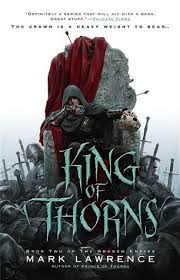
2‑King of Thorns
Chapter 32: Four years earlier
by Mark, Lawrence,The chapter “31: Four years earlier” serves as a flashback, providing critical context to the events unfolding in *King of Thorns*, the second installment of *The Broken Empire* series. It revisits a pivotal moment in the protagonist’s past, shedding light on the formative experiences that shaped his ruthless and strategic mindset. The narrative shifts tone to reflect the younger, less hardened version of the character, contrasting his earlier vulnerabilities with his present dominance. This temporal shift underscores the themes of power, trauma, and transformation central to the series.
The flashback reveals key incidents that directly influence the protagonist’s current motivations and conflicts. By delving into his past, the chapter explores the origins of his alliances, rivalries, and the scars—both physical and emotional—that define him. The prose is gritty and visceral, mirroring the brutal world of the Broken Empire, where survival often hinges on cunning and violence. The chapter’s title, “Four years earlier,” signals a deliberate narrative pivot, inviting readers to reassess the protagonist’s actions through the lens of his history.
Through this retrospective, the author deepens the reader’s understanding of the protagonist’s moral ambiguity and the sacrifices he has made to ascend to power. The chapter hints at unresolved tensions and buried secrets that may resurface in the present timeline, adding layers of suspense and complexity. The flashback also introduces secondary characters whose roles in the past reverberate into the current storyline, emphasizing the interconnectedness of events across time. The writing maintains a taut, immersive quality, ensuring the past feels as immediate and consequential as the present.
Ultimately, this chapter serves as a bridge between the protagonist’s past and present, enriching the narrative with psychological depth and historical weight. It challenges readers to grapple with the cost of ambition and the blurred lines between heroism and tyranny. By juxtaposing the protagonist’s earlier innocence with his later ruthlessness, the chapter underscores the transformative—and often destructive—power of trauma and ambition. This flashback not only advances the plot but also reinforces the series’ exploration of how legacy and memory shape destiny in a fractured world.
FAQs
1. What is the significance of the chapter title “31: Four years earlier” in the context of King of Thorns: Book Two of the Broken Empire?
Answer:
The chapter title “31: Four years earlier” suggests a flashback or a shift in the narrative timeline, providing crucial background information about events that occurred four years prior to the main storyline. This technique is often used to deepen character development or explain motivations and past conflicts. In King of Thorns, such a temporal shift likely serves to reveal key moments in the protagonist’s journey, such as formative experiences or decisions that shaped his current circumstances. The number “31” may indicate the chapter’s placement in the book or symbolize a specific countdown or milestone in the plot.2. How does the structure of this chapter (a brief, standalone segment) contribute to the pacing or thematic depth of King of Thorns?
Answer:
The brevity and standalone nature of this chapter create a deliberate pause or reflective moment in the narrative, allowing readers to absorb earlier events or anticipate future developments. Such chapters often serve as thematic anchors, emphasizing a pivotal moment or revelation. In King of Thorns, this structure might highlight the weight of the “four years earlier” timeline, forcing readers to contrast past and present character dynamics or plot twists. The minimalistic approach could also intensify suspense, leaving room for interpretation while maintaining narrative momentum.3. If this chapter is indeed a flashback, what narrative purpose might it serve for the protagonist’s arc in King of Thorns?
Answer:
A flashback in this context likely unveils critical backstory, such as the protagonist’s earlier struggles, alliances, or betrayals that inform his current actions. For example, it might explore a formative battle, a personal loss, or a moral dilemma that hardened his resolve or fueled his ambitions. By revisiting “four years earlier,” the author could underscore themes of power, revenge, or redemption, showing how past events haunt or drive the protagonist. This technique deepens reader empathy and contextualizes his present choices, making his arc more nuanced and compelling.4. Why might the author choose to omit detailed content in this chapter, relying instead on a sparse title and minimal text?
Answer:
The sparse presentation could be a stylistic choice to evoke mystery, urgency, or introspection. By omitting details, the author may invite readers to focus on the implications of the timeline shift (“four years earlier”) rather than specific events, encouraging them to mentally bridge gaps between past and present. Alternatively, it might signify a deliberate narrative ellipsis, where the omitted content is revealed later for dramatic effect. This approach can heighten tension and engage readers’ curiosity, making them actively piece together the story’s puzzle.
Quotes
1. “The memories of men are too frail a thread to hang history from.”
This quote underscores the unreliability of human memory as a record of truth, a recurring theme in the chapter that questions how history is constructed and preserved.
2. “Four years can change a man. Four years can unmake him.”
This pivotal line captures the chapter’s exploration of transformation and trauma, marking the temporal shift in the protagonist’s journey and the weight of elapsed time.
3. “The Broken Empire doesn’t forgive. It doesn’t forget. It waits.”
A chilling statement about the relentless nature of power in this world, representing the chapter’s examination of political consequences and enduring vengeance.
4. “Kings die. Real power lies in who tells the story afterward.”
This insightful quote reveals the book’s central thesis about narrative control being the ultimate form of power, appearing as the chapter reflects on historical manipulation.
5. “I’d rather be sharp and whole than blunt and complete.”
The protagonist’s defining philosophy, capturing his pragmatic worldview that drives his decisions throughout the chapter and the larger narrative.
